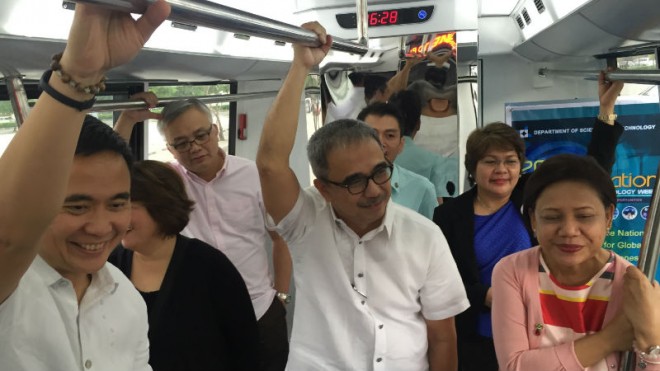
Transportation Secretary Joseph Emilio “Jun” Abaya (left) tries the hybrid electric road train of the Department of Science and Technology with Science Secretary Mario Montejo (middle) and Senator Cynthia Villar (right). Photo by Nestor Corrales/INQUIRER.net
Will hybrid trains ease traffic jams along Edsa?
The Department of Science and Technology (DOST) has rolled out its “Hybrid Electric Road Train” to provide an alternative solution to the worsening condition of mass transportation in Metro Manila.
Local scientists and engineers of the DOST have developed a 40-meter hybrid road train, which could accommodate a maximum of 240 passengers.
The hybrid train has five interlinked air-conditioned coaches, with four coaches that could load up to 40 passengers each. The train is powered by a hybrid engine running on electric batteries or diesel fuels at a maximum speed 50 kilometers per hour.
The train has an elevated engine that could operate even with floods.
The train, which was launched last June in Clark, Pampanga, was featured during the Science and Technology Week in Pasay City.
READ: PH-made ‘road trains’ go on test run in Clark
Science Secretary Mario Montejo said the hybrid train could be a cost-effective mode of transportation, citing that the government has been spending billions of funds to subsidize the country’s currently active trains systems.
Montejo said the hybrid train cost 45 million pesos to develop in a span of three years.
Asked when the hybrid train could be seen plying along Edsa, Transportation Secretary Joseph Emilio “Jun” Abaya said it would depend on the interest of the private sector.
“The private sector should come in. Makumbinsi sila sa teknolohiya at sila ang mgapatakbo nito (They should trust in technology and they will be the ones to run this),” Abaya said after he rode the train around the Mall of Asia in Pasay City.
Once the private sector picks up the technology, more trains could be produced, he said.
Planning required
The transport official said deployment of the train on Edsa or in major thoroughfares in Metro Manila should be planned.
“It should be planned. Hindi ‘yung its mere deploying this. It’s not as simple as that,” he said.
Abaya said the hybrid train plying through Edsa is feasible but “the challenge is to give us space on Edsa.”
He said the train could have a dedicated lane on Edsa but it has to be discussed with the Metro Manila Development Authority (MMDA).
The prototype of the Hybrid Electric Road Train developed by local scientists and engineers of the Department of Science and Technology (DOST). Photo by Nestor Corrales/INQUIRER.net
Also, if the hybrid train would need to be registered and accredited by the Land Transportation Office (LTO) the moment its goes fully commercialized.
“That’s a process in itself. It’s not a matter of months,” Abaya said.
The hybrid train is seen to at least ease the congested mass transit in Metro Manila particularly the Metro Rail Transit (MRT-3).
The MRT-3 ridership has swollen to about 600,000 commuters a day, far above its 350,000 projected daily capacity.
The DOST said it would need 60 hybrid trains to serve the 600,000 passengers using the MRT-3. IDL